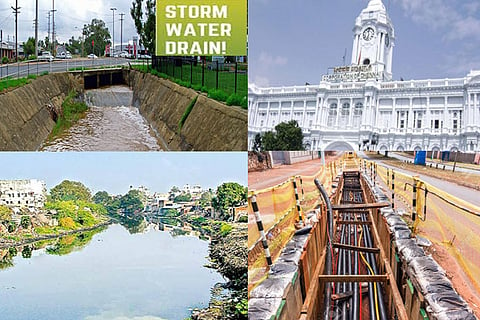

Chennai
Since 1991, Tamil Nadu has witnessed nine cyclones with wind speeds exceeding 100 km/hr, with the most recent ones being Cyclone Vardah in 2016 and Cyclone Gaja in 2018. Less than two hours into rainfall, the majority of the city and its arterial roads tend to get water-logged. This year, the onslaught of Cyclone Nivar caused inundation and the entry of rainwater mixed with sewage into hundreds of homes.
While the Corporation’s efforts must be commended, the recent cyclone places even more emphasis on the creation of pre-emptive failsafe measures to be part of Chennai’s response when it comes to such an inevitable phenomenon. Earlier in March, the Corporation had stated one of its top priorities in the 2020-21 budget would be the creation of Integrated Storm Water Drains (ISWD). The value of these projects aimed at tackling flooding and safeguarding the lives of lakhs of people living in deluge-prone areas was estimated to be Rs 350 cr (provisional allocation), out of a total budget of Rs 3,800 cr.
But in September, residents in many localities raised concerns about monsoon preparedness, and the desilting of stormwater drains, which took a backseat due to the pandemic-led lockdown. To add to their woes, the level of mechanisation employed by the Corporation leaves a lot to be desired as the onus is on manual labour, which was in short supply, owing to the fear of infection during COVID. The Commissioner had then directed Regional Deputy Commissioners to ensure work was completed on 1,497 roads, under the aegis of the Chennai Mega City Development Mission (CMCDM) and the Tamil Nadu Urban Road Infrastructure Fund (TURIF) before the end of September. As many as 2,971 roads were slated to be repaired before the onset of the monsoon. Also, a deadline had been set to restore about 72 water bodies before the rains hit Chennai.
However, reports from October said 70 pc of the stormwater drain network of the city was yet to be desilted. About 3.2 lakh tonnes of silt was to be removed from the city’s stormwater drain channels, which span a network of 1,700 km. The process of desilting was in progress in 7,365 structures, and one lakh tonnes of silt was removed by the third week of October. Similarly, out of 63 temple tanks, 20 have been restored as of last week, while 130 of 210 ponds have been cleared of refuse and desilted.
The question of stormwater drains is just one aspect of dysfunction during a flood. A major health hazard during such climatic emergencies is the risk of electrocution due to the snapping of overhead power lines. At both ECR and OMR, the nerve centres of Tamil Nadu’s IT industry, a significant risk is posed by overhead cables, despite the fact these roads are relatively new constructions. Last year in July, Electricity Minister P Thangamani informed the Assembly it would take two years for the conversion of overhead high tension and low tension electric cables to underground cables in Chennai. The network to be covered is 6,532 km-long.
Big budgets and weighty promises aside, Chennaiites have grown tired of encountering the same encumbrances year after year, during the monsoons. This year, woes are compounded by the one-two punch of the pandemic too. How many more lives must be lost to the mouths of exposed manholes, uncovered drains and snapped power lines, before the administration can start to address issues from the bottom up?
Visit news.dtnext.in to explore our interactive epaper!
Download the DT Next app for more exciting features!
Click here for iOS
Click here for Android